On the 23 September of this year, the KNVB announced the appointment of Frank de Boer as manager of the Dutch national team. This appointment followed the departure of Ronald Koeman who was hired by Barcelona at the end of August. He had previously worked with the Dutch national side in 2010 at the World Cup as the assistant manager to Bert van Marwijk, the head coach at the time.
De Boer was quite a controversial appointment amongst Dutch fans and pundits as he has had quite a dismal managerial career in recent times. From 2010-2016, de Boer was regarded as one of the brightest up-and-coming coaches in the world following four straight Eredivisie title wins from 2011-14.
However, after he left Amsterdam and became the head coach of the Italian giants, Inter, his career took quite a dive, with sackings at Inter, Crystal Palace, and Atlanta United.
De Boer was a part of Louis van Gaal’s coaching dynasty at both Ajax and Barcelona through the 90s and 00s, alongside world-renowned coaches such as Pep Guardiola, Frank Rijkaard, Luis Enrique, Phillip Cocu, Ajax’s current CEO Edwin van der Sar, etc. It was a dynasty that would go on to shape the future of football.
Louis van Gaal was the Netherlands manager on two separate occasions, most notably for the 2014 World Cup where they shocked the world and finished third despite having one of the worst Dutch teams on paper in recent memory. Frank de Boer has always been compared to his teacher, Louis van Gaal, in terms of how his sides like to play and how he coaches, having played under the Dutchman for such a long period of his career.
In this tactical analysis, we will be taking a look at the Netherlands under new manager Frank de Boer. It will be an analysis of the Netherlands from their opening games and will be a comparison of his side’s tactics with Louis van Gaal’s 2014 World Cup team.
Lineups and formations:
The only players remaining from Louis van Gaal’s World Cup side that are still playing under Frank de Boer’s regime are Jasper Cillessen, Daley Blind, Stefan de Vrij, Memphis Depay, Georginio Wijnaldum, Joel Veltman, and Tim Krul.
These seven players were all included in de Boer’s squad for his first round of international games last month, where they played Mexico in a friendly, as well as Bosnia and Herzegovina and Italy in the UEFA Nations League.
However, there is generally a completely different and younger side six years on from their third-place World Cup finish.
This was a typical lineup for the Netherlands during the World Cup;
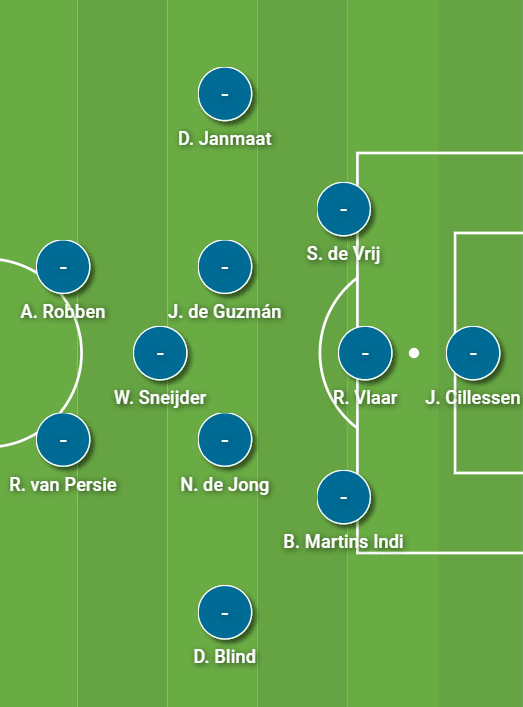
Van Gaal generally deployed a 4-1-4-1 or a variation of the 4-3-3 throughout the qualifiers for the tournament until Kevin Strootman, who was one of the focal points of the squad, picked up an injury so van Gaal changed the system to a 5-2-1-2 or a 5-2-3 depending on the opposition.
The starting goalkeeper has remained exactly the same with both managers. Jasper Cillessen of Valencia has been a mainstay for many years now since his days at Ajax. The backline consisted of Bruno Martins Indi of AZ Alkmaar, Stefan de Vrij, and Ron Vlaar, with Daryl Janmaat and Blind, utilised as the wing-backs.
Nigel de Jong replaced Strootman at the time and sat in a double-pivot alongside Jonathon de Guzman. The legendary Wesley Sneijder played just ahead of them in a more advanced attacking midfield role and operated in the space just behind two of the best players in the world at the time, Arjen Robben and Robin van Persie.
Frank de Boer has utilised a back five variation so far with the national team, in a 1-1 draw with Italy, however, his most used formation has been the 4-2-3-1.
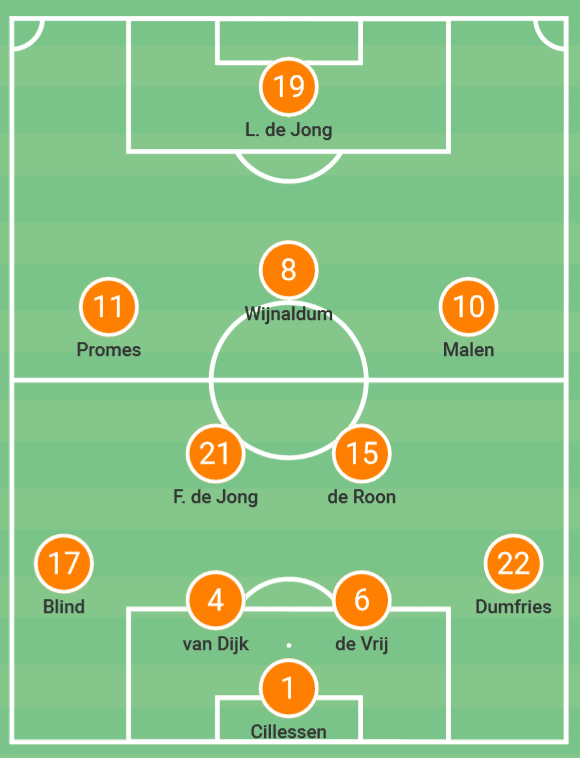
The image above is the most used starting eleven and formation by the Dutch coach.
He also used a double-pivot in midfield despite the difference in formation. Frenkie de Jong and Marten de Roon complement each other nicely in this partnership as they combine intricate and brilliant passing with defensive and tactical intelligence.
The front three of Quincy Promes, who made his debut for the national team under van Gaal, Donyell Malen, and Luuk de Jong, is vastly different from the World Cup side’s forward line. Despite van Persie’s decent aerial ability, he started in the side because of his ruthless goalscoring prowess, whereas de Jong is more of a target man, with Malen and Promes also being majorly different to Sneijder and Robben.
De Boer’s front line is more centred around pace and link-up play.
Louis van Gaal’s set up in possession:
Louis van Gaal’s philosophy was very much a possession-based philosophy all throughout his career. This, of course, did not change with his Holland side at the World Cup. As they used the 5-2-1-2 formation, there was always seven to eight players involved in the build-up phase.
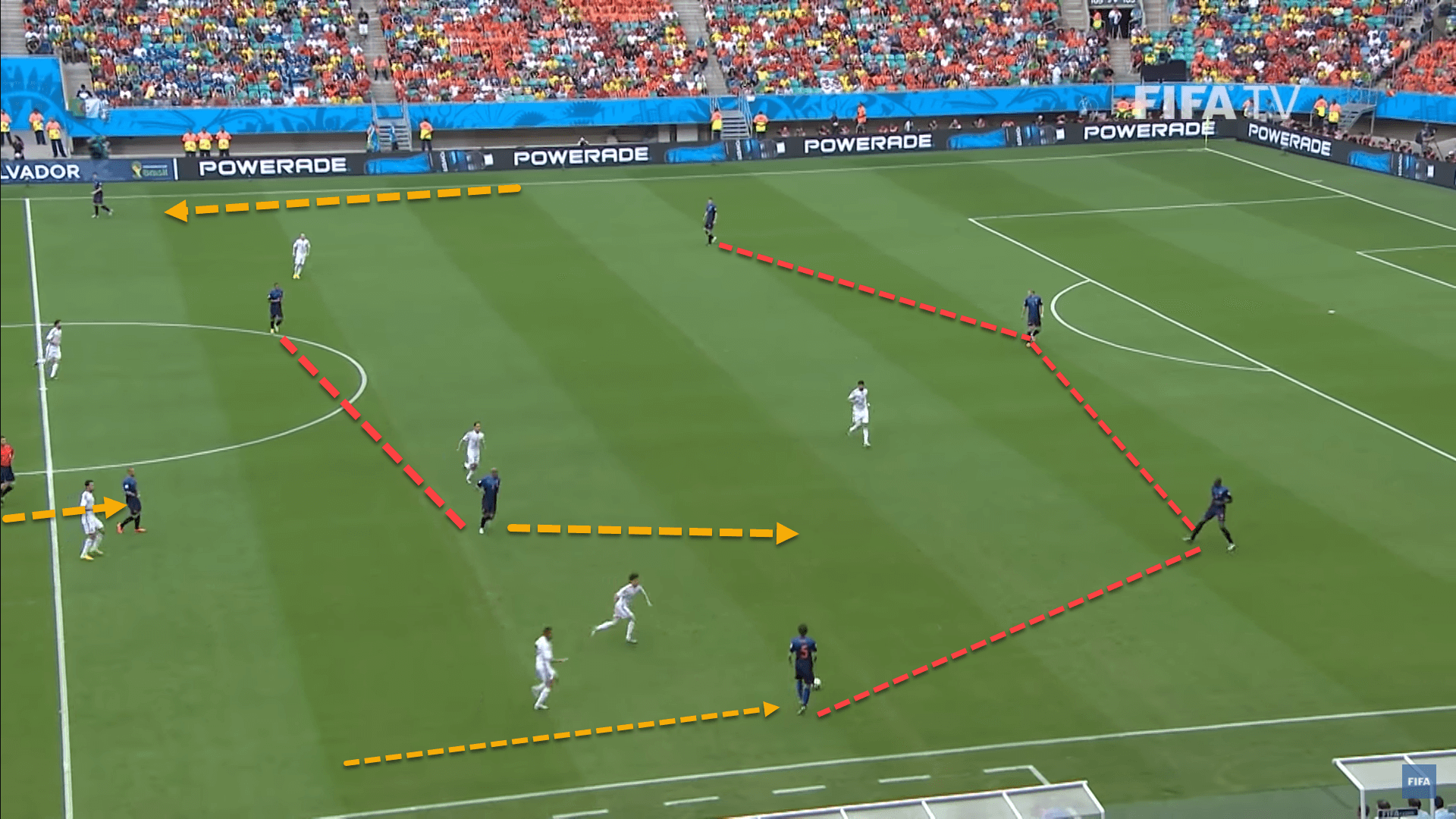
The above image is an example of how the Netherlands set up in the build-up phase of the attack during their World Cup run six years ago. The three centre-backs split very wide to cover the width of the pitch. This allowed the wing-backs to get further forward.
The ball-near wing-back dropped deep to act as a passing option in order to help circulate the ball around the backline. The ball-far wing-back pushed further forward in order to act as a progressive switch of the play. In the example above, we can see this in action. Blind, who is currently on the ball, has dropped short next to Indi to help the backline shift possession around, meanwhile, Janmaat on the far side can be seen pushing forward so as to be a switch of the play option for the Dutch side.
The double-pivot was extremely hard-working in possession as they had to cover the entirety of the central areas including the half-spaces. When the ball was in the central areas, they maintained their positioning next to each other in front of the backline, but when the ball was moved to the wide areas, as can be seen above, the ball-near pivot would drop short to create a triangle. These triangles would allow them to outnumber their opponents who pressed.
Another example of this build-up play can be seen here:
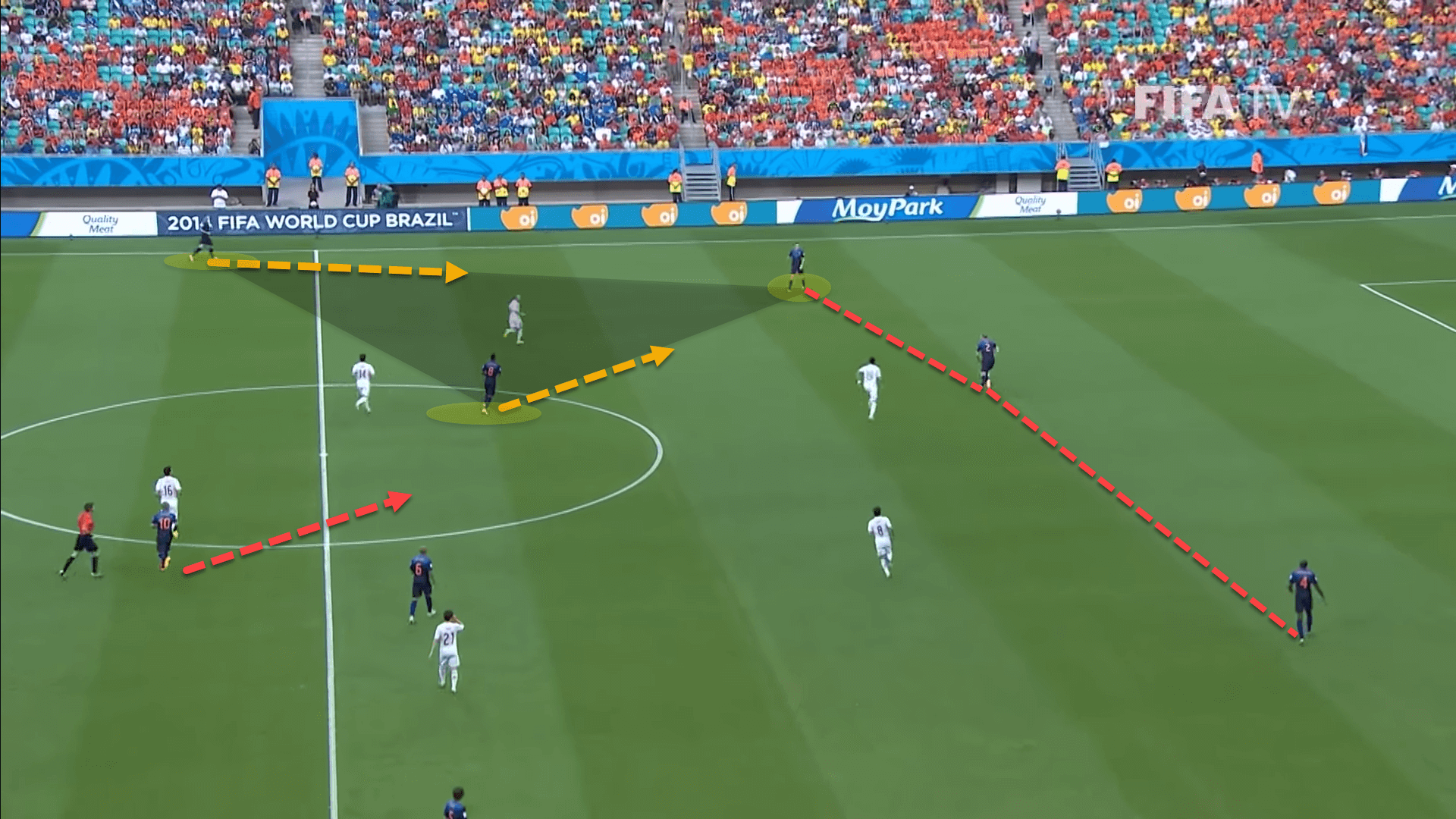
Sneijder had a free role during the build-up phase. He would usually operate between the lines, however, if the Netherlands were struggling to shift the ball around, he would also drop into the space in front of the opposition’s midfield line.
Frank de Boer’s side in possession:
Frank de Boer has clearly learned from his teacher, as there are quite a lot of similarities between his Dutch side in possession in contrast to the 2014 World Cup side.
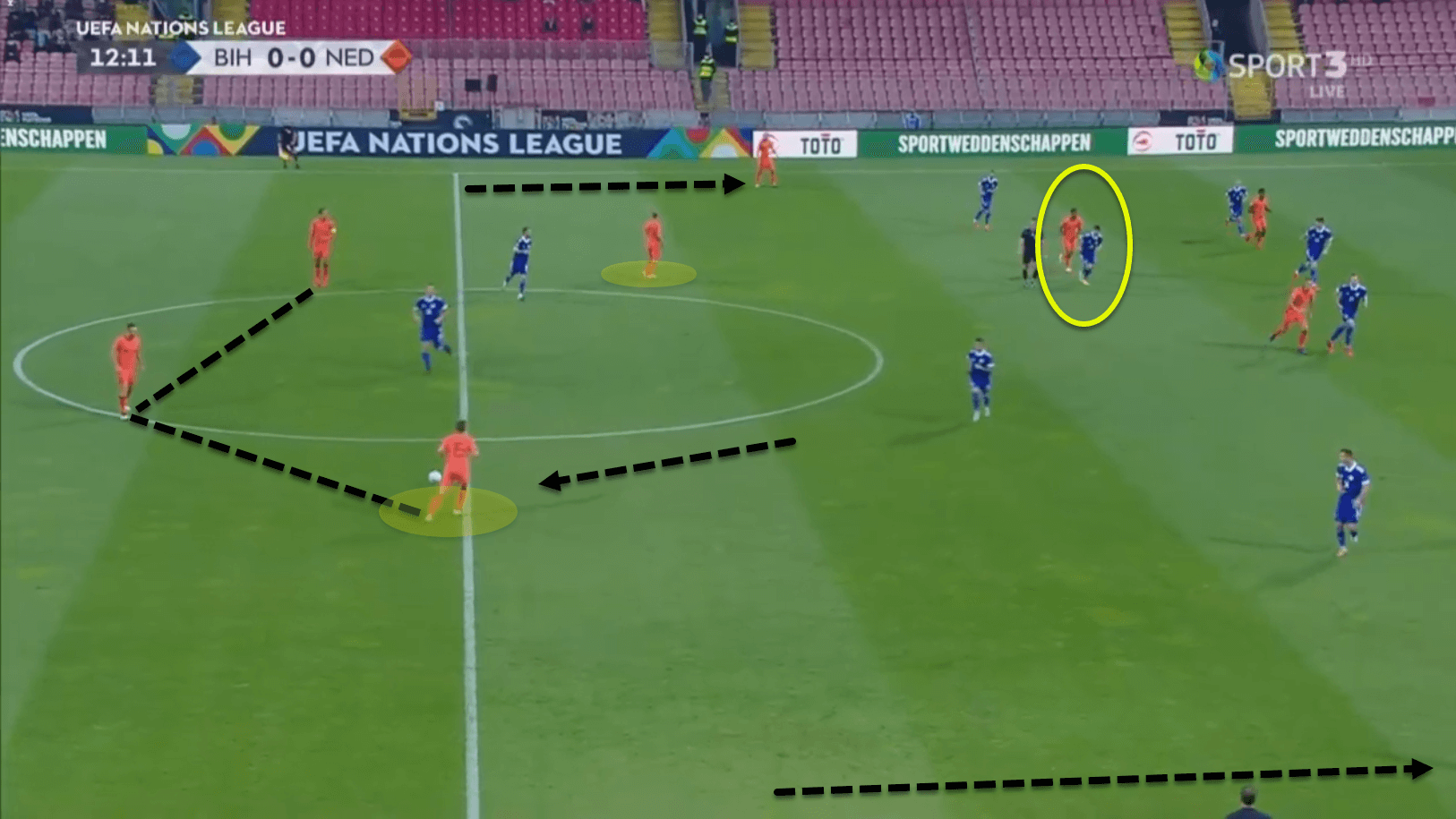
The use of the double-pivot is of course one of the biggest similarities. De Jong and de Roon have to be extremely mobile too during the possession phases as they are constantly moving towards the ball side. This is so that they are always involved in the play, but it also so that they can be close by to counterpress in case Holland lose possession.
Since they tend to play a back four formation, the ball-near pivot player drops next to the centre-backs to create a back 3. This is because the most used formation out of possession is a 4-4-2 where the opposition have two players in their first line of press. By one of the double-pivot dropping in as a third centre-back, it allows Holland to create a 3 v 2 situation so that they cannot be outnumbered.
When the ball-near pivot player drops into these areas, it also gives license for both of the full-backs to get high and wide. In the previous image, we can see de Jong telling Blind to go forward as de Roon has moved to become a third centre-back.
The attacking midfielder, usually Wijnaldum, operates in a similar role to Sneijder. If the backline players are struggling to breakdown the opposition’s press, he will drop next to the double-pivot so to create an overload allowing them to easily play out.
The Netherlands in the 5-3-2/3-1-4-2 shape deployed by de Boer set out to apply the same principles and patterns as in the 4-2-3-1, however, de Jong was used as a single-pivot rather than in a double-pivot. This can be seen in the following image:
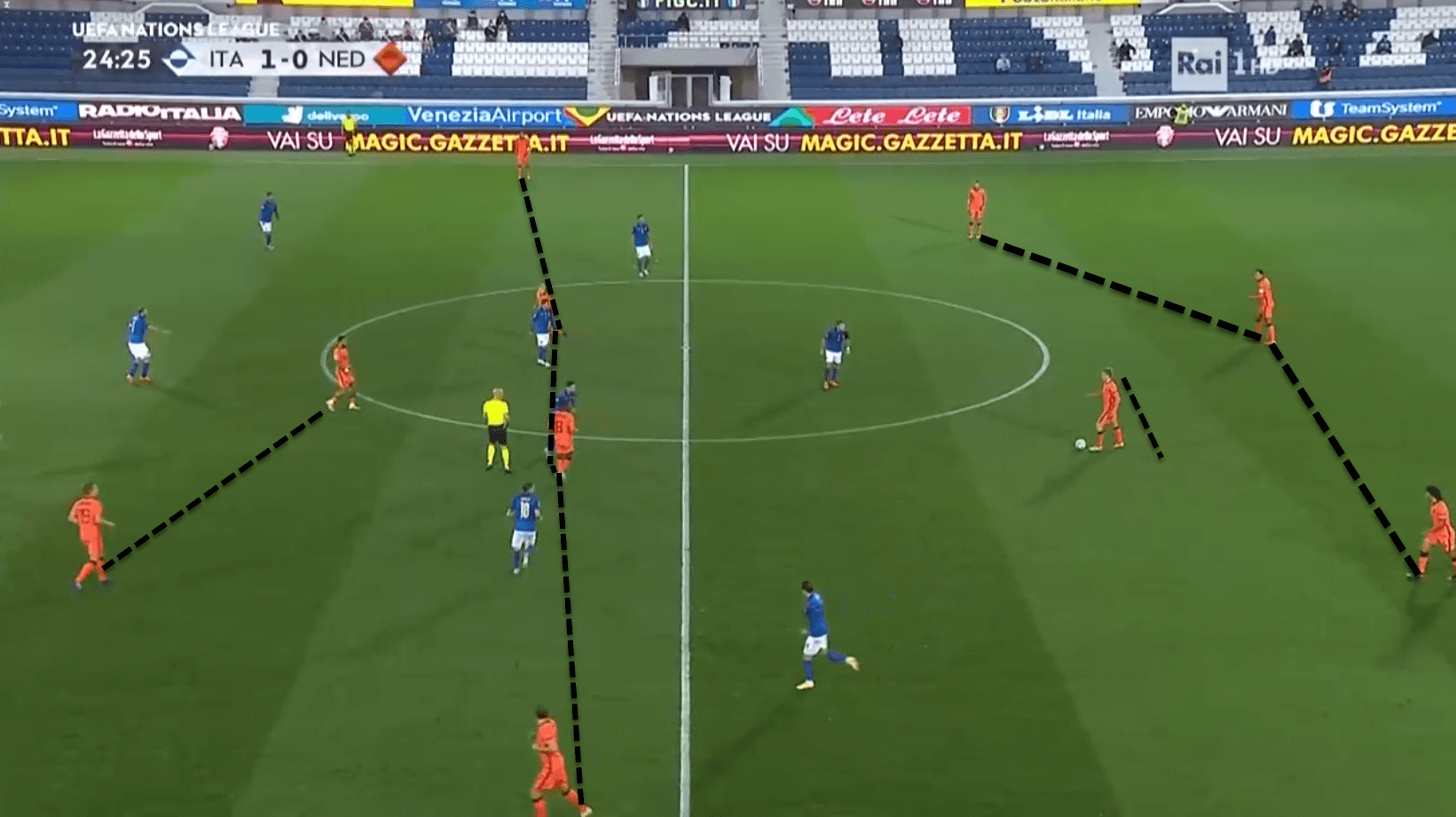
The image above is from their 1-1 draw against Italy. Despite de Boer deploying a 5-3-2 in this game, the central midfield three still operates in the same fashion as in a 4-2-3-1. De Jong sits just in front of the backline, picking the ball up from them and looking to advance forward, whilst the progressive midfielders pick up positions behind the opposition’s midfield line so that de Jong can play through.
Again, the wing-backs provide the width, whilst the centre-forwards also operate between the lines.
Difference in both managers’ attacking styles:
Once the Netherlands progress forward, they like to create triangles on the flanks in order to break through the opposing team’s defensive line. In their two UEFA Nations League fixtures against Bosnia and Italy, the Netherlands recorded 74 of their 109 attacks from the flanks, which is an astronomical percentage of attacks from the wide areas.
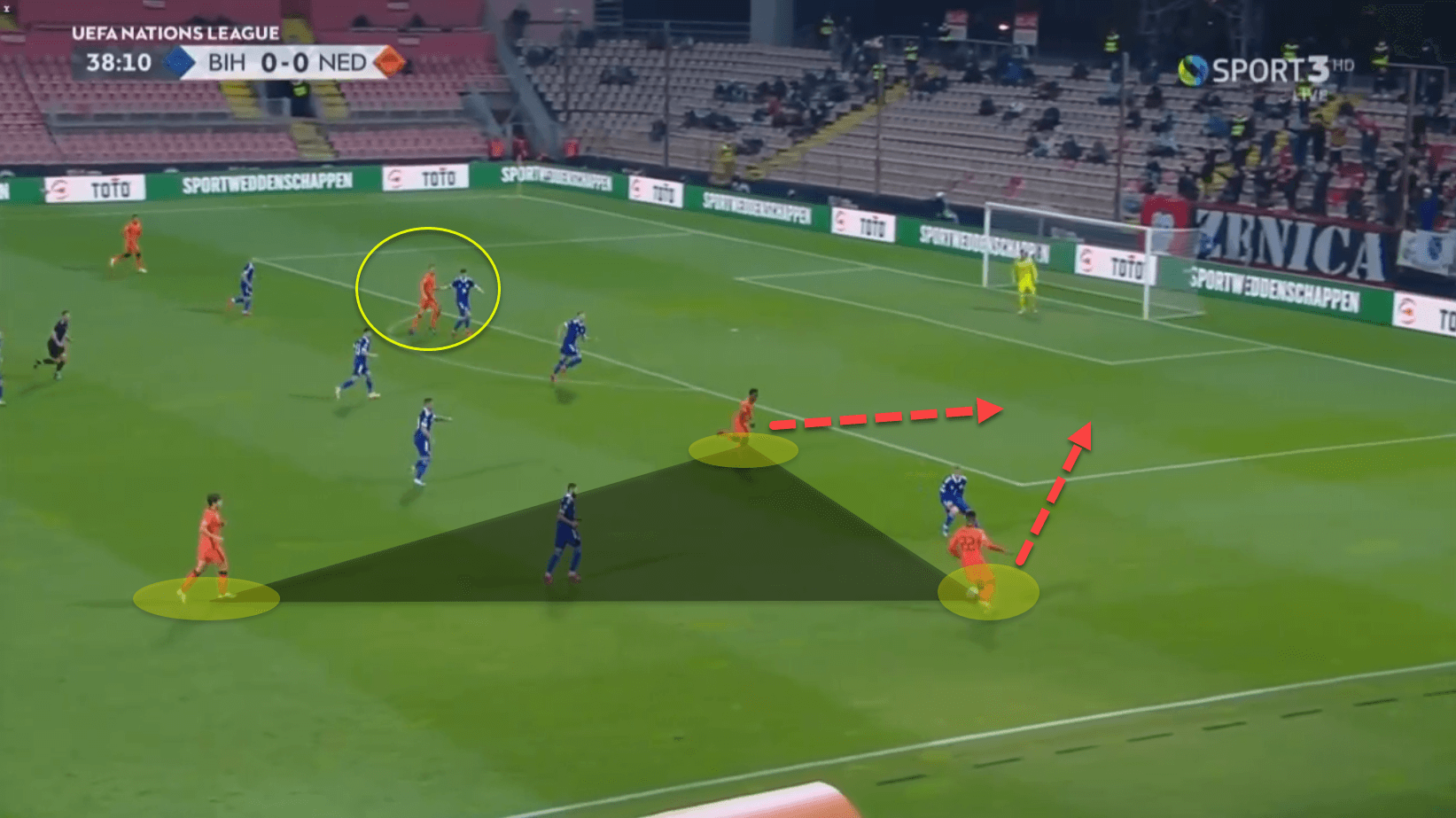
Here is an example of how the Dutch side attack under de Boer. The wingers drift inside and pick up positions in the halfspaces, as this allows for the advancement of the full-backs in the wide areas, which is a very common tactical trend in modern football. The ball-near pivot player then shifts across to create a triangle.
As can be seen in the footage above, the fullback receives the ball on the right-hand side, attracting the Bosnian left-back out and forcing space to open up on the defender’s blindside for the winger to attack. The ball-near pivot player, in this case, de Roon, is there to provide support. If the full-back cannot make a progressive pass, they simply just play it to the pivot player and allow for possession to be recycled.
Having de Jong in the side also gives them an aerial advantage. If they are not able to break down the opposition’s defensive low block, they will attempt to cross the ball to the big target man who is extremely potent in the air. Against Bosnia alone, as they sat in a low block, the Netherlands put in 30 crosses towards de Jong.
Van Gaal’s approach when looking to penetrate the opposition’s defence was different. Admittedly de Boer has a far better squad currently, compared to in 2014 when the national team was vastly inexperienced aside from a few of the older players.
They were very patient whilst in possession in the build-up phase of the attack, however, once they managed to get into progressive areas, they were instructed by van Gaal to force passes. He did this by splitting both of his centre-forwards, van Persie and Robben, and positioning them in the channels. Once the Netherlands broke the opposition’s press, they would instantly make darting runs in behind the backline. They used this attacking strategy to great effect, none more notable than van Persie’s famous header against Spain from this exact passage of play.
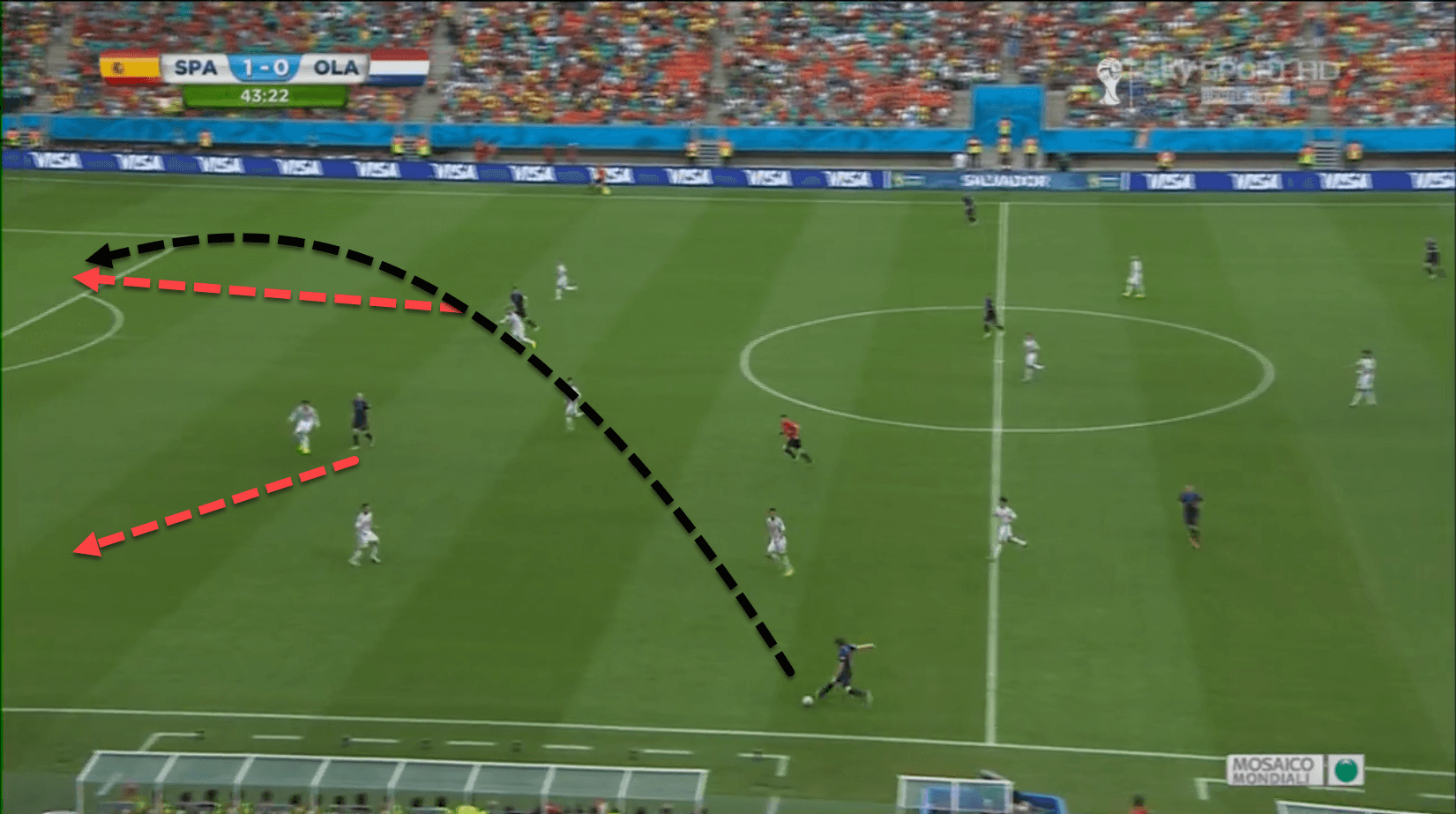
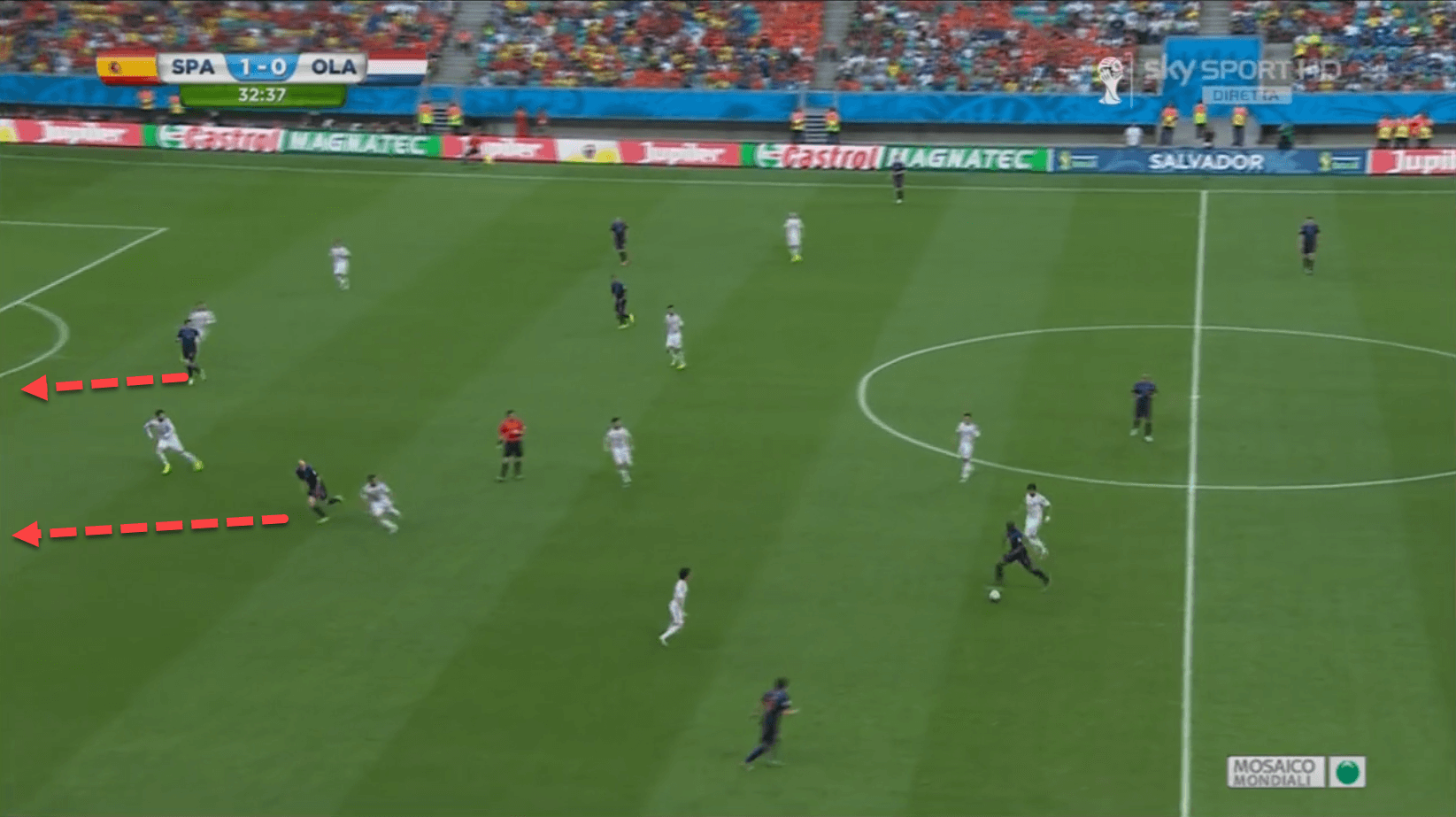
Similarities in their defensive approach:
At Manchester United, Louis van Gaal was often criticised for being too defensive with the ball and that United held onto possession for vast periods of time without creating a chance in order to control the game and wear the opposition out. This may be a fair statement and certainly the same may be said about his Dutch team during his second term in charge, but what cannot be disputed is his side’s determination to win the ball back as quickly as possible once they lost it.
Once they lost possession, they counter-pressed the ball to win it back as high up the pitch as they could. They generally did this with 2-3 of the nearest players smothering the ball-carrier, which would either force a mistake, a turnover of possession, or would delay the counterattack allowing the rest of the team to regain their defensive shape.
However, even when they did have their defensive shape, which was typically a 5-2-1-2 mid-to-high block, they would press the opposition high and aggressively to try and win back possession. The great Dutch coach did this by deploying a man-marking-based and very aggressive, pressing system.
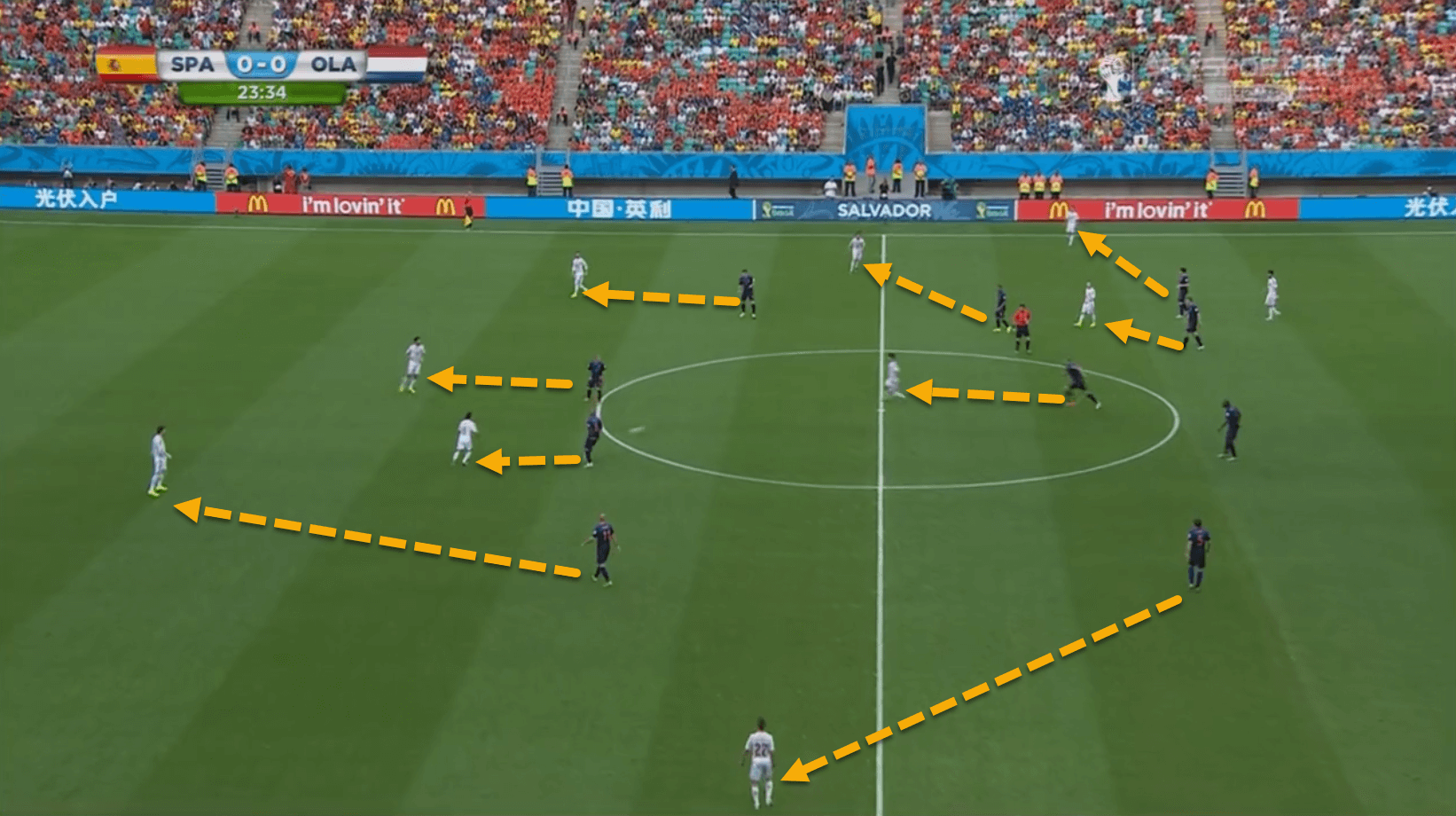
In the image above, the tight man-marking pressing system can be seen in full flow. Each player was given a player from the opposition to mark out of possession in order to never give the opponent room on the ball to turn or have too long to pick a pass out. This system worked quite well for them as it forced their opponents to make a mistake, allowing the Netherlands to hit them on the break.
This particularly worked against lesser opposition who were less comfortable in possession and were prone to mistakes, however, against teams who utilise midfield rotations, such as Spain in the image above, space could be easily made to play through the Dutch’s defensive block with midfield movements.
Frank de Boer’s Netherlands side also counterpress when they lose possession. They try to box their opposition into an area of the field, mainly the wide areas and create a numerical superiority to regain possession.
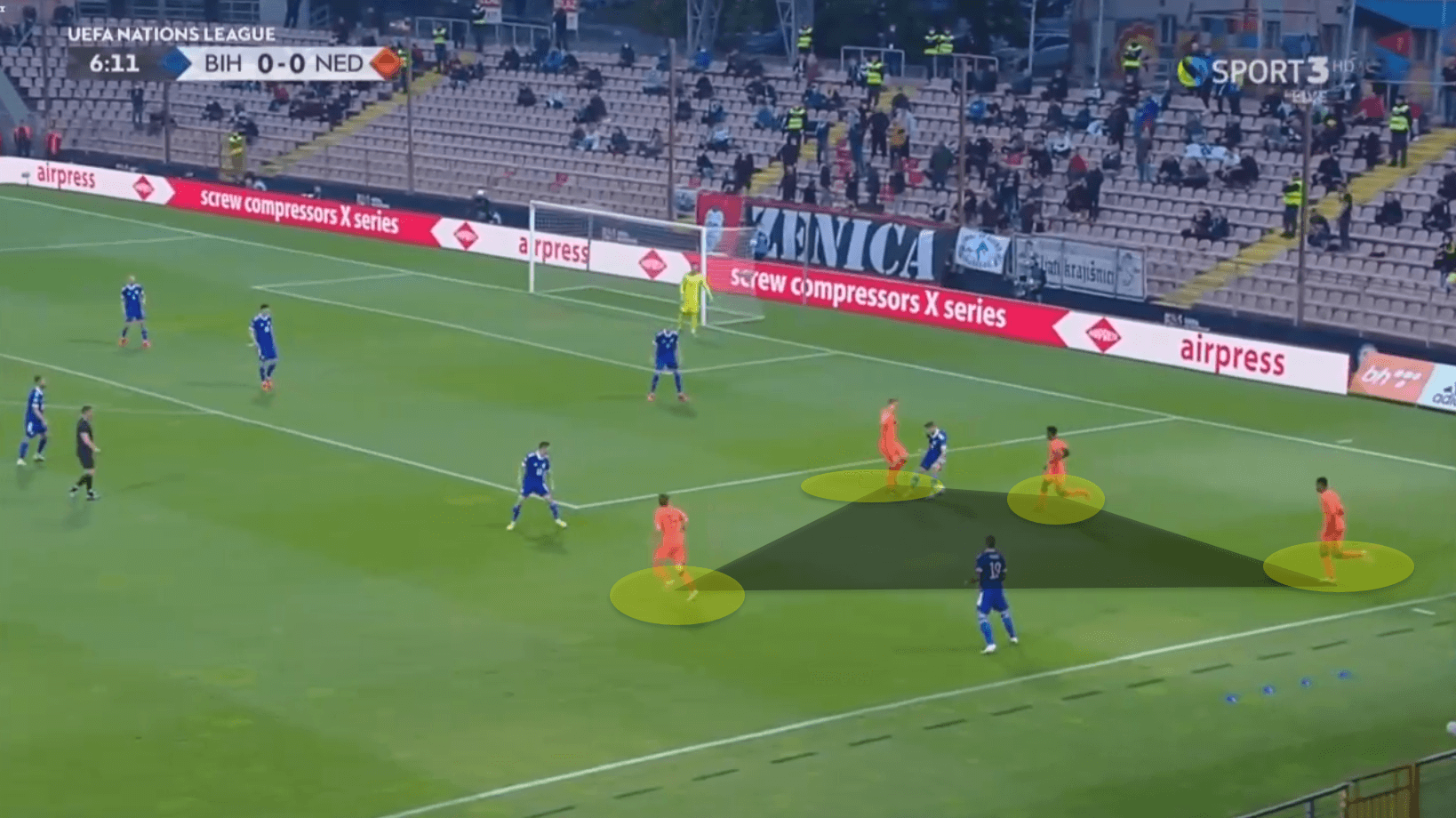
In contrast with van Gaal’s team, de Boer instructs his players to counterpress with 3-4 players instead of 2-3. The aim is not just delaying the counterattack, it is to guarantee a turnover of possession. If this fails though, it leaves their backline greatly exposed, which Italy took advantage of several times in their recent game against Holland, even scoring once.
In their two competitive matches against Bosnia and Italy, the Netherlands boasted 58 recoveries in the opponents’ half, which is a fantastic number.
De Boer also uses a man-marking pressing system out of possession. The objective is to force the opponent into playing out to the wide areas where they can be boxed in, much like Holland’s counter-pressing strategy.
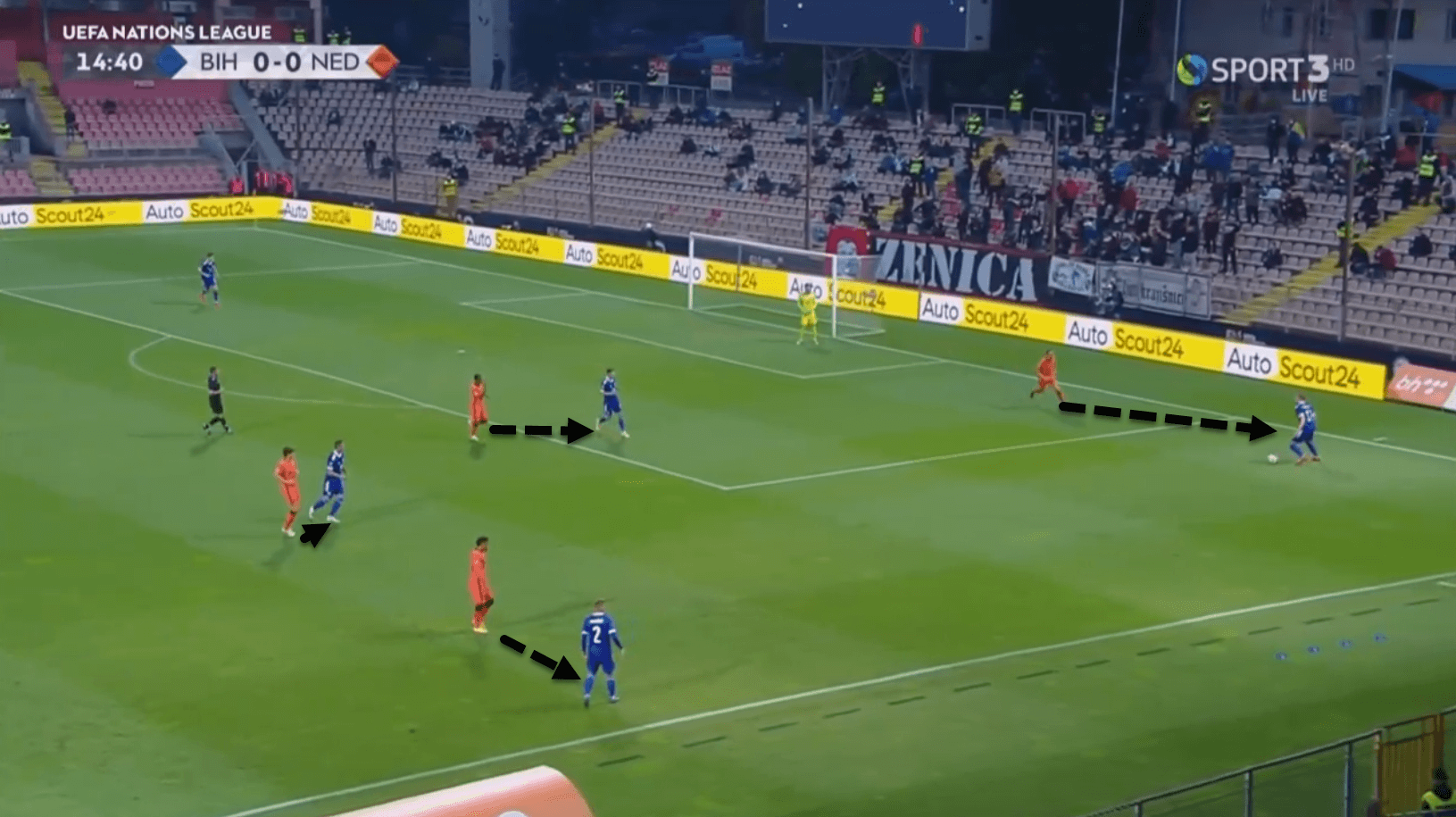
Conclusion:
It is very clear that Frank de Boer learned a lot from his teacher, Louis van Gaal, throughout his career, as he has drawn plaudits for playing a very similar style of football to the legendary Dutch manager. Even in his first three games in charge of the national side, his tactics have been compared to that of the van Gaal blueprint.
So far, despite losing one and drawing two of his opening games as manager, the Netherlands have still looked fantastic in many areas. The only area where they lack in is creating clear-cut chances and more goalscoring opportunities. However, with the upcoming European Championships on the horizon, as well as the next World Cup, de Boer will be hoping that he can take the national side one step further than van Gaal and potentially win an international trophy.

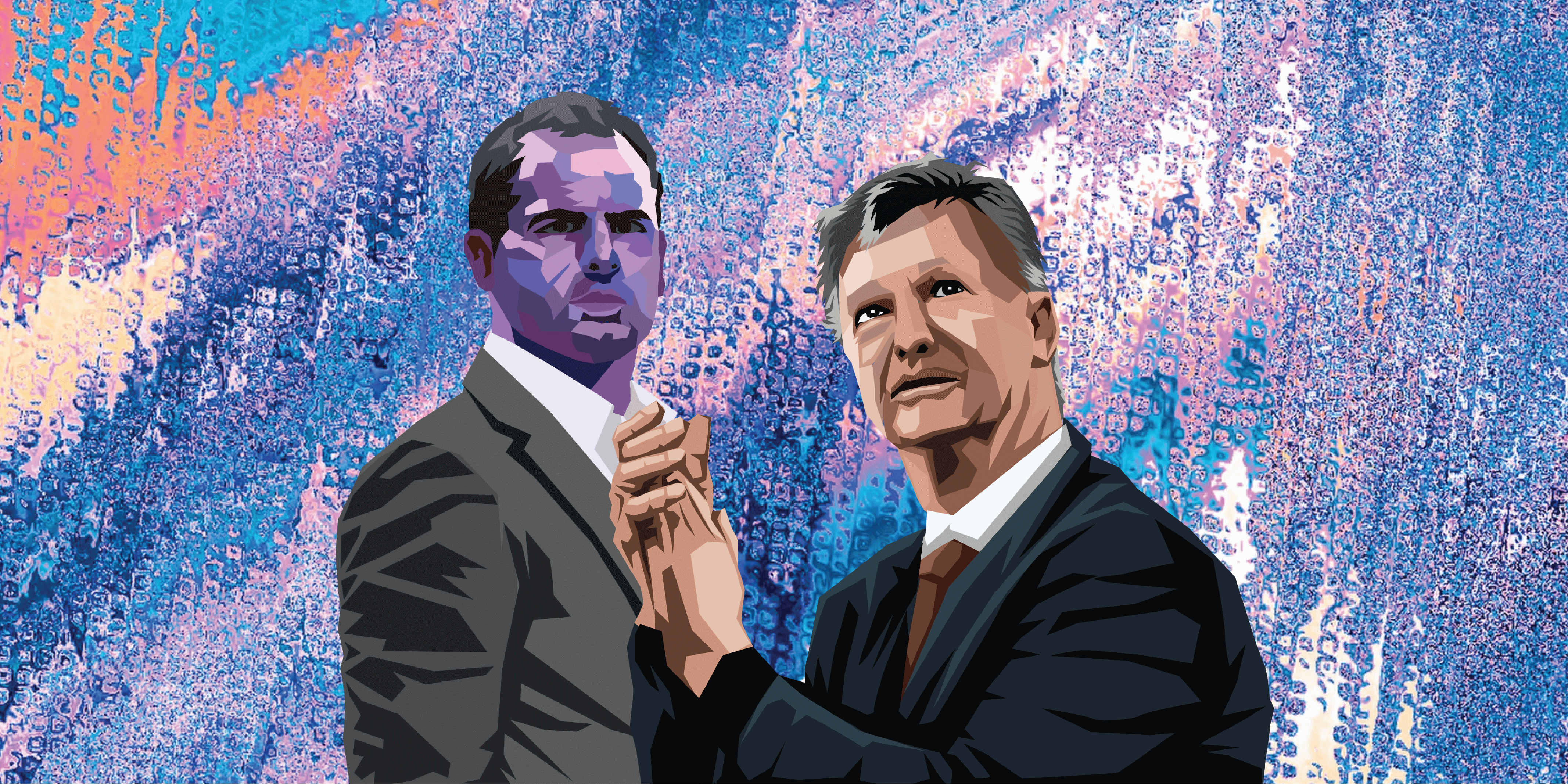




Comments